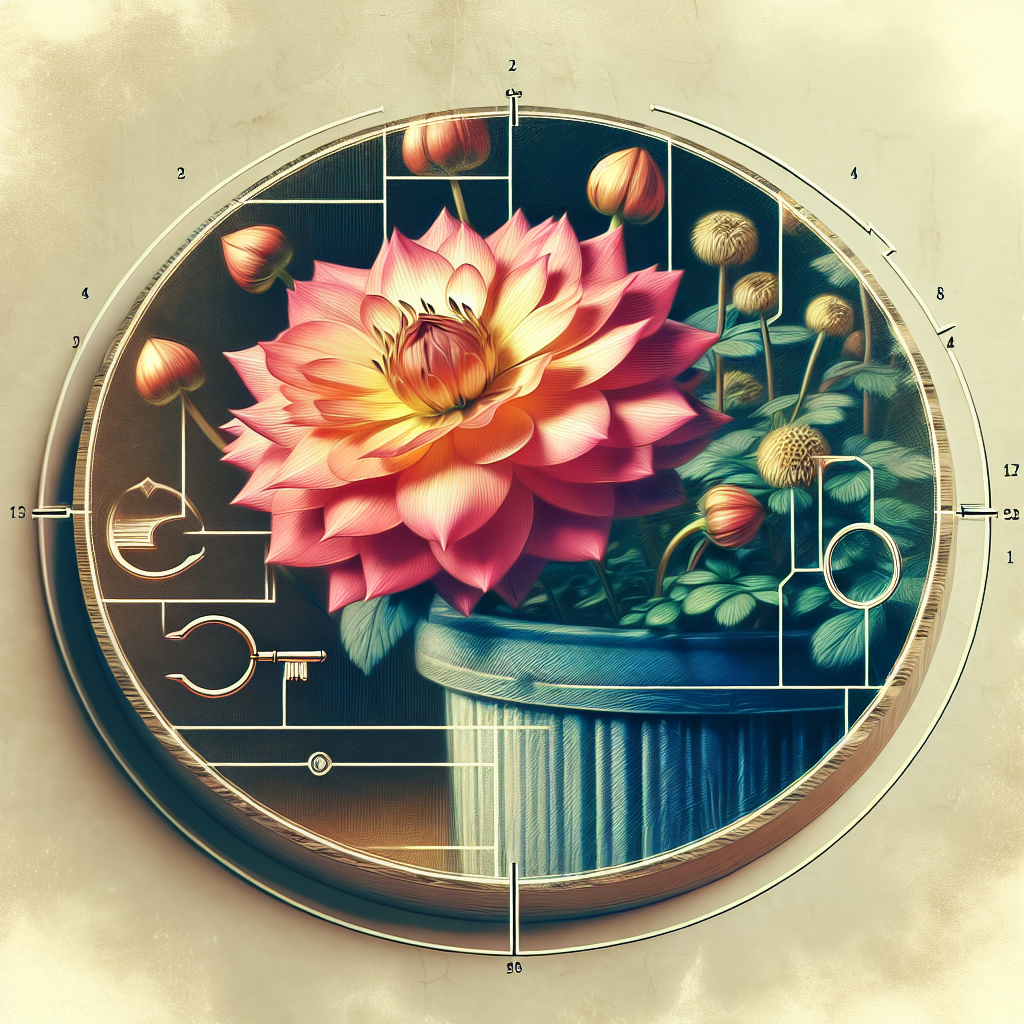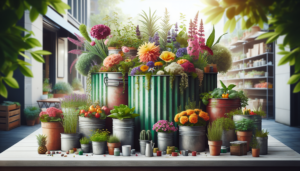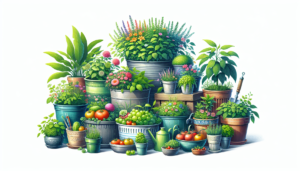
Are you looking for a simple and attractive way to start gardening? Look no further! Creating a beautiful container keyhole garden is a fantastic way to bring nature right to your doorstep. A container keyhole garden is a compact and convenient option that allows you to grow a variety of plants in a small space, making it perfect for balconies, patios, or even small gardens. With a little creativity and some basic gardening supplies, you can transform any container into a stunning container keyhole garden that will bring joy and beauty to your surroundings.
Choosing the Right Container
Consider the size and depth
When choosing a container for your keyhole garden, it’s important to consider the size and depth. The container should be large enough to accommodate the plants you want to grow, with ample room for their roots to spread out. The depth of the container is also crucial, as it determines how much soil the plants will have access to. A deeper container allows for better water retention and root growth, leading to healthier and more robust plants.
Look for proper drainage
Another important factor to consider when choosing a container for your keyhole garden is proper drainage. Without adequate drainage, excess water can accumulate in the container, leading to root rot and other moisture-related issues. Look for containers with drainage holes at the bottom to allow excess water to escape. Alternatively, you can also choose containers with a built-in drainage system or self-watering mechanisms to ensure a healthy growing environment for your plants.
Opt for lightweight materials
When it comes to container materials, it’s generally recommended to opt for lightweight options. This is especially important if you plan on moving or rearranging your keyhole garden frequently. Lightweight containers are easier to handle and transport, making it convenient to adjust your garden’s layout or relocate it to different areas based on sunlight and accessibility. Common lightweight container materials include plastic, fiberglass, and composite materials, which are durable and weather-resistant.
Selecting the Ideal Location
Evaluate sunlight conditions
To ensure the success of your container keyhole garden, it’s crucial to evaluate the sunlight conditions of the chosen location. Most plants require a certain amount of sunlight to grow properly, so it’s important to select a spot that receives adequate sunlight throughout the day. Observe the area for a few days to determine how much sunlight it gets and whether it aligns with the sunlight requirements of the plants you wish to grow. This will help you choose the right location for your keyhole garden and promote optimal plant growth.
Ensure easy accessibility
When selecting the location for your container keyhole garden, it’s also important to ensure easy accessibility. Consider placing the garden in an area that is easily reachable so that you can tend to your plants without any hassle. This includes watering, pruning, and harvesting the crops. Having convenient accessibility to your garden will make it more enjoyable to care for and maintain, ultimately leading to a healthier and more flourishing container garden.
Consider nearby water source
Another aspect to consider when choosing the location for your container keyhole garden is the proximity to a water source. While most container gardens require regular watering, having a nearby water source can simplify the watering process. It could be a faucet, rainwater harvesting system, or even a nearby hose. Easy access to water will make it more convenient for you to provide adequate moisture to your plants, especially during dry spells or hot summer months.
Preparing the Container
Clean the container
Before planting your keyhole garden, it’s important to clean the container thoroughly. This will help remove any potential contaminants or debris that could hinder plant growth or introduce pests or diseases. You can clean the container by scrubbing it with a mixture of mild dish soap and water, ensuring to rinse it thoroughly afterwards. This step will provide your plants with a fresh and clean environment to grow in.
Create drainage holes
To facilitate proper drainage and prevent waterlogged soil, creating drainage holes in your container is essential. Depending on the material of your container, you can use a drill for plastic or wooden containers, or a hammer and nails for ceramic or terracotta pots. Aim to create several evenly spaced holes at the bottom of the container to allow excess water to drain freely. This simple step will help prevent waterlogging and promote aeration for healthy root development.
Add a layer of gravel or stones
After creating drainage holes in your container, it’s beneficial to add a layer of gravel or stones at the bottom. This acts as a drainage layer and helps to prevent the soil from compacting or becoming waterlogged. The gravel or stones allow water to flow freely through the soil, preventing the roots from sitting in stagnant water. This simple addition can greatly improve the overall drainage and health of your container keyhole garden.
Choosing the Right Soil
Use a high-quality potting mix
Choosing the right soil is essential for the success of your container keyhole garden. Instead of using regular garden soil, which can become compacted and may contain weeds or pests, opt for a high-quality potting mix. Potting mixes are specially formulated to provide excellent drainage and aeration, ensuring healthy root growth for your plants. Look for potting mixes that contain a blend of compost, peat moss, and perlite or vermiculite for optimal plant nutrition and moisture retention.
Add organic matter for nutrients
To further enrich the soil in your container keyhole garden, consider adding organic matter such as compost or well-rotted manure. Organic matter is rich in nutrients and helps improve soil fertility, promoting healthy plant growth. Mix in a generous amount of organic matter with the potting mix before filling up the container. This will provide your plants with a steady supply of nutrients throughout their growing season.
Ensure proper pH levels
Ensuring proper pH levels is another important aspect of choosing the right soil for your container keyhole garden. Different plants have different pH preferences, so it’s crucial to select a potting mix that matches the pH requirements of your chosen plants. Many potting mixes are pH-balanced, but it’s always a good idea to check the pH levels using a soil testing kit. Adjusting the pH, if necessary, will create an optimal growing environment for your plants and promote nutrient uptake.
Selecting Suitable Plants
Consider the container size
When selecting plants for your container keyhole garden, it’s crucial to consider the size of the container. Smaller containers are suitable for compact or trailing plants, while larger containers can accommodate larger and more vigorous plants. Ensure that the plants you choose have enough space to grow without overcrowding the container. This will allow each plant to thrive and spread its roots, leading to healthier and more productive growth.
Choose plants with similar water and sunlight needs
To simplify the maintenance of your container keyhole garden, it’s advisable to choose plants with similar water and sunlight needs. This ensures that all plants in the container receive the same level of care and attention. Mixing plants with different water or sunlight preferences can make it difficult to meet their individual requirements, leading to stress or poor growth. Research the water and sunlight preferences of the plants you wish to grow and select varieties that are compatible with each other.
Include a mix of flowers, herbs, and vegetables
To create a visually appealing and diverse container keyhole garden, it’s recommended to include a mix of flowers, herbs, and vegetables. Flowers add color and beauty to the garden, while herbs provide aromatic foliage and delicious flavorings for your cooking. Vegetables allow you to grow your own fresh produce and enjoy the satisfaction of harvesting your own food. By including a variety of plants, you can create a harmonious and balanced container garden that caters to your aesthetic and practical preferences.
Arranging the Plants
Place taller plants in the center
When arranging the plants in your container keyhole garden, it’s a good idea to place taller plants in the center. This creates a focal point in the garden and adds height and structure. Taller plants can include ornamental grasses, upright flowers, or climbing vines. Placing them in the center allows for a visually pleasing arrangement and ensures that they don’t overshadow or shade out the smaller plants around them.
Position trailing plants along the edges
To create a cascading effect and add visual interest to your container keyhole garden, position trailing plants along the edges. Trailing plants, such as ivy, sweet potato vine, or trailing petunias, will spill over the sides of the container, softening the edges and creating a lush and abundant look. Their cascading growth habit adds a sense of movement and dynamism to the garden, enhancing its overall appeal.
Arrange smaller plants in between
To fill in the spaces between the taller and trailing plants, arrange smaller plants in between. These can include compact flowers, herbs, or vegetables. By strategically placing these smaller plants, you can create a balanced and cohesive composition, ensuring that every inch of the container is utilized effectively. This approach maximizes the visual impact of your container keyhole garden and creates an attractive and harmonious display.
Providing Adequate Watering
Water deeply and thoroughly
Watering is a crucial aspect of maintaining a healthy container keyhole garden. To ensure that your plants receive enough moisture, it’s important to water deeply and thoroughly. This means watering until the water flows out of the drainage holes and ensuring that the entire root ball is moistened. Deep watering encourages the roots to grow deep into the soil, making the plants more resilient and less susceptible to drought stress.
Monitor soil moisture levels
While deep watering is important, it’s equally important to monitor the moisture levels of the soil in your container keyhole garden. Stick your finger about an inch into the soil to check for moisture. If it feels dry, it’s time to water the plants. On the other hand, if the soil feels consistently wet or waterlogged, it indicates overwatering, which can lead to root rot and other issues. By monitoring the moisture levels, you can strike a balance and ensure that your plants receive just the right amount of water.
Avoid overwatering
One common mistake many gardeners make is overwatering their container plants. Overwatering can lead to root rot, fungal diseases, and the overall decline of plants. To avoid overwatering, it’s important to let the top inch or two of soil dry out slightly before watering again. This allows for proper oxygenation of the roots and prevents waterlogged conditions. Remember that it’s better to slightly underwater than to overwater, as most plants can tolerate short periods of dryness.
Adding Mulch for Moisture Retention
Choose organic mulch materials
Adding mulch to your container keyhole garden provides numerous benefits, including moisture retention, weed suppression, and temperature moderation. When selecting mulch materials, opt for organic options such as straw, shredded leaves, or wood chips. Organic mulch materials break down over time, adding organic matter to the soil and improving its fertility. They also create a natural and aesthetically pleasing layer on top of the soil, enhancing the overall appearance of your container garden.
Apply a layer around the plants
To ensure maximum moisture retention, apply a layer of mulch around the plants in your container keyhole garden. The mulch layer should be around 2-3 inches thick and should not touch the stems or leaves of the plants. This layer acts as a barrier, preventing water evaporation from the soil surface and reducing weed growth. It also helps to regulate soil temperature, keeping the roots cool during hot weather and insulating them during colder periods.
Replenish mulch periodically
Over time, organic mulch materials break down and decompose. To maintain the benefits of mulching, it’s important to replenish the mulch periodically. Depending on the rate of decomposition, you may need to add a fresh layer of mulch every few months or at the beginning of each growing season. Replenishing the mulch layer not only ensures continued moisture retention and weed suppression but also provides a consistent and attractive appearance to your container keyhole garden.
Feeding and Fertilizing
Use a balanced slow-release fertilizer
To provide the necessary nutrients for your container keyhole garden, it’s advisable to use a balanced slow-release fertilizer. Slow-release fertilizers provide a steady and prolonged supply of nutrients, ensuring optimal plant growth and health. Look for fertilizers specifically designed for container plants, as they contain the necessary nutrients in the right proportions. Follow the fertilizer manufacturer’s instructions for application rates and frequency.
Follow manufacturer’s instructions
When it comes to fertilizing your container keyhole garden, it’s important to follow the manufacturer’s instructions for the specific fertilizer you are using. Different fertilizers have different application rates, and applying too much or too little can have negative effects on plant growth. Pay attention to the recommended dosage and timing, and adjust accordingly based on the specific needs of your plants.
Apply fertilizer at recommended intervals
To maintain the health and vigor of your container keyhole garden, it’s essential to apply fertilizer at recommended intervals. Most slow-release fertilizers are designed to release nutrients gradually over a certain period of time, typically several months. Reapply the fertilizer according to the manufacturer’s instructions to ensure a constant supply of nutrients for your plants. Regular fertilization will keep your plants thriving and producing abundant blooms or bountiful harvests.
Maintaining and Pruning
Regularly inspect for pests and diseases
Regularly inspecting your container keyhole garden for pests and diseases is crucial for early detection and prevention. Pests such as aphids, mites, or caterpillars can quickly damage or destroy your plants if left unattended. Similarly, diseases such as powdery mildew or blight can spread rapidly and affect the overall health of your garden. Inspect the leaves, stems, and flowers of your plants for any signs of damage, discoloration, or abnormal growth. By catching pest and disease issues early, you can take appropriate measures to control and mitigate any potential damage.
Prune to maintain desired shape and size
Pruning is an important maintenance practice for your container keyhole garden. It helps to maintain the desired shape and size of your plants, encourages bushier growth, and enhances overall plant health. Regularly trim dead or wilted foliage, remove spent flowers, and prune any unwanted or overgrown branches. Proper pruning techniques will promote air circulation, reduce the risk of diseases, and direct the plant’s energy towards healthy growth and flowering.
Remove dead or wilted foliage
It’s important to remove dead or wilted foliage from your container keyhole garden to maintain its overall appearance and prevent the spread of diseases. Dead or wilted leaves can serve as breeding grounds for pests and a source of fungal or bacterial infections. Regularly inspect your plants and remove any such foliage by gently snapping or cutting them off at the base. This will ensure a tidy and healthy container garden that continues to thrive.
Creating a beautiful container keyhole garden requires careful consideration and planning. By choosing the right container, selecting an ideal location, preparing the container, using the right soil, selecting suitable plants, arranging them effectively, providing adequate watering, adding mulch, feeding and fertilizing appropriately, and maintaining and pruning diligently, you can enjoy a vibrant and flourishing container keyhole garden that brings you joy and satisfaction throughout the gardening season. With a friendly tone of voice and comprehensive information, this article serves as a helpful guide for anyone looking to embark on the journey of creating a stunning container keyhole garden.







